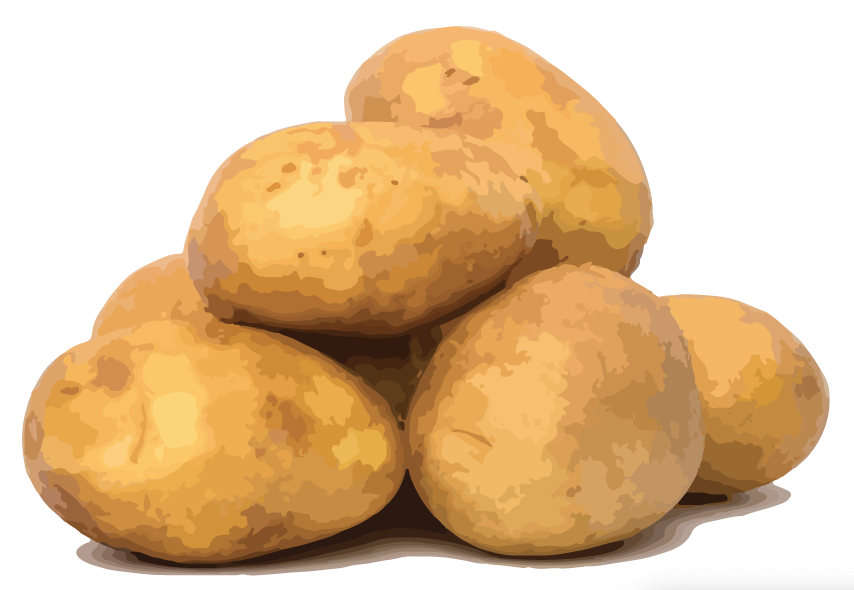Eat Smart, Move More at Farmers Markets: Potatoes
ID
HNFE-320-3NP

Key Points
- A good source of vitamin C, potassium, vitamin B6, and fiber.
- Potatoes should be clean, firm, smooth, dry, and uniform in size.
- Wash hands with warm water and soap for at least 20 seconds before and after handling fresh fruits and vegetables.
- Store potatoes in a cool, dark, well-ventilated place for use within three to five weeks. Protect potatoes from light to avoid greening.
Green Bean, New Potato and Ham Salad
Number of servings: 12
Ingredients:
3 pounds new potatoes, cleaned and quartered
1 pound fresh green beans, stems removed and broken into bite-size pieces
3/4 cup low-fat mayonnaise
1/3 cup brown mustard
2 tablespoons red wine vinegar
2 cups ham, chopped into cubes
4 green onions, chopped
Directions:
- Cover quartered potatoes and green beans with cold water and bring to a boil. Reduce heat and simmer for 30 minutes.
- Meanwhile, whisk together mayonnaise, brown mustard, and red wine vinegar.
- When potatoes are tender, drain and allow to cool slightly. Mix in mayonnaise mixture along with ham and green onions. Serve warm or cold.
Per serving: 189 calories; 7 g fat (1 g saturated fat); 8 g protein; 25 g carbohydrate; 3 g dietary fiber; 18 mg cholesterol; 467 mg sodium.
Roasted New Potatoes
Number of servings: 5
Ingredients:
1 1/2 pounds new potatoes, cleaned and cut in bite-size pieces
Freshly ground black pepper to taste
2 tablespoons canola oil
1 teaspoon fresh rosemary, minced
1/4 teaspoon garlic powder
Directions:
- Heat oven to 450°F. Place potatoes in a large bowl. Sprinkle with pepper, canola oil, rosemary, and garlic powder. Toss until potatoes are well-coated.
- Spread the potatoes on a single layer of a roasting pan (use a sturdy pan that can take high oven heat; a standard cookie sheet may warp). Roast for 40 minutes or until potatoes are cooked through and browned. Serve immediately.
Per serving: 156 calories; 6 g fat (2 g saturated fat); 3 g protein; 25 g carbohydrate; 2 g dietary fiber; 0 mg cholesterol; 8 mg sodium.
Quick Tips
- You can easily microwave a potato. Scrub potato under running water. Prick several times with a fork or knife and place on a microwaveable plate. Potatoes can be cooked and eaten whole without peeling them; potatoes provide more fiber if they are not peeled. Be aware that oven wattages for cooking may vary by manufacturer.
- Potatoes are the most popular vegetable among children in the U.S. Be sure to limit white potatoes to “sometimes” foods and try not to serve them fried. Compared to other vegetables, potatoes don’t offer as much nutritional value.
- Clean potatoes and other firm-skinned produce under running tap water while rubbing with your hands or scrubbing with a clean brush.
- Use pureed, cooked potatoes to thicken soups and stews.
This institution is an equal opportunity provider. In accordance with Federal law and U.S. Department of Agriculture (USDA) civil rights regulations and policies, this institution is prohibited from discriminating on the basis of race, color, national origin, sex, age, disability, and reprisal or retaliation for prior civil rights activity. (Not all prohibited bases apply to all programs.) This material was partially funded by USDA’s Supplemental Nutrition Assistance Program – SNAP – and the Expanded Food and Nutrition Education Program (EFNEP). SNAP is funded by the U.S. Department of Agriculture Food and Nutrition Service and the Expanded Food and Nutrition Education Program (EFNEP) is funded by the U.S. Department of Agriculture, National Institute of Food and Agriculture (USDA/NIFA).
Virginia Cooperative Extension materials are available for public use, reprint, or citation without further permission, provided the use includes credit to the author and to Virginia Cooperative Extension, Virginia Tech, and Virginia State University.
Virginia Cooperative Extension is a partnership of Virginia Tech, Virginia State University, the U.S. Department of Agriculture, and local governments. Its programs and employment are open to all, regardless of age, color, disability, sex (including pregnancy), gender, gender identity, gender expression, national origin, political affiliation, race, religion, sexual orientation, genetic information, military status, or any other basis protected by law
Publication Date
February 9, 2021



